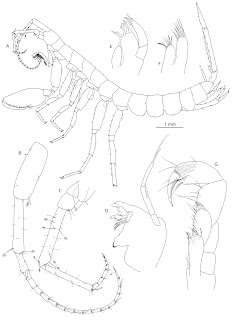 |
| Pilbarana grandis Stringer & King, in Stringer, King, Austin et Guzik. 2022. |
Abstract
The Pilbara and nearby regions in north-western Western Australia have an exceptionally high diversity of short-range endemic invertebrates inhabiting threatened groundwater-dependent habitats. Amphipod crustaceans, in particular, are dominant in these communities, but are poorly understood taxonomically, with many undescribed species. Recent molecular phylogenetic analyses of Pilbara eriopisid amphipods have, nonetheless, uncovered a previously unknown biodiversity. In this study, we formally establish a new genus, Pilbarana Stringer & King gen. nov., and describe two new species, P. grandis Stringer & King sp. nov. from Cane River Conservation Park and P. lowryi Stringer & King sp. nov. from the Fortescue River Basin near the Hamersley Range, using a combination of molecular and morphological data. The new genus is similar morphologically to the two additional Western Australian eriopisid genera, Nedsia Barnard & Williams, 1995 and Norcapensis Bradbury & Williams, 1997, but represents a genetically divergent, reciprocally monophyletic lineage, which can be differentiated by its vermiform body shape, the presence of an antennal sinus, and by the length and form of the antennae and uropods. This research signifies an important contribution to knowledge of Pilbara subterranean communities and has critical implications for future environmental impact assessments and conservation management.
Keywords: Crustacea, Amphipoda, arid zone, groundwater-dependent ecosystems, stygofauna, taxonomy
 |
| Pilbarana grandis sp. nov. holotype male WAM C78830, 7mm. A, whole animal with scale; B, antenna 1; C, antenna 2; D, mandible; E, maxilla 1; F, maxilla 2; G, maxilliped. |
Taxonomy
Infraorder Hadziida S. Karaman, 1932 (Lowry & Myers, 2013)
Superfamily Hadzioidea S. Karaman, 1943 (Bousfield, 1983)
Family Eriopisidae Lowry & Myers, 2013
Pilbarana Stringer & King gen. nov.
Type species: Pilbarana grandis sp. nov.
Included species: Pilbarana grandis sp. nov. and Pilbarana lowryi sp. nov.
Diagnosis. Head with weakly concave antennal sinus. Antenna 1 not longer than half body length. Maxilla 1 inner plate
with one distal robust seta. Coxae reduced, with coxae 1–4 lengths (depths) distinctly shorter than pereonite lengths;
coxae 1–2 anteriorly projected/produced, coxae 3–4 with small to indistinct anterior lobe and associated seta(e),
posterior lobe indistinct, coxae 5–7 with anterior lobe gradually less distinct (coxae 5–6 anterior lobe with associated
setae), posterior lobe very small. Coxal gills present on coxae 3–6, sternal gills absent. Pereonite 1 with concave
posterodistal corner; pereonites 2–7 laterally square-shaped, as broad as long, vermiform body shape. Gnathopod 1
carpus at least 3.5 times as long as broad, longer than propodus; propodus with palm distinctly transverse. Gnathopod
2 propodus approximately 4.5 times length of carpus, palm enlarged, strongly oblique. Pereopods 5–7 basis not
distinctly expanded posteriorly, pereopod 7 without lobe on posterodistal corner. Uropod 1 peduncle 2 times length
of rami, with one or more robust basofacial seta(e). Uropod 3 strongly extended, distinctly larger than uropod 1; outer
ramus cylindrical, larger than inner ramus and apically concave.
Etymology. The name Pilbarana references the Pilbara region of Western Australia where this genus is found. The gender should be considered as female.
 |
| Pilbarana lowryi sp. nov. holotype female WAM C78833, 8.7 mm. A, whole animal with scale; B, antenna 1; C, antenna 2; D, mandible; E, maxilla 1; F, maxilla 2; G, maxilliped. |
Danielle N. Stringer, Rachael A. King, Andrew D. Austin and Michelle T. Guzik. 2022. Pilbarana, A New Subterranean Amphipod Genus (Hadzioidea: Eriopisidae) of Environmental Assessment Importance from the Pilbara, Western Australia. Zootaxa. 5188(6); 559-573. DOI: 10.11646/zootaxa.5188.6.4